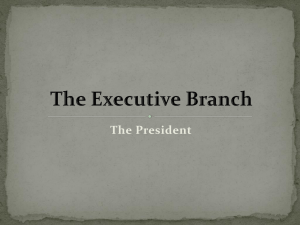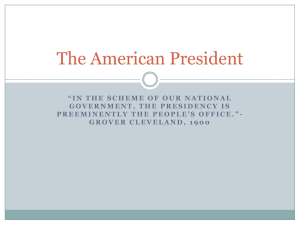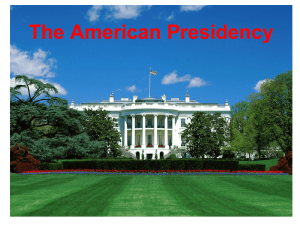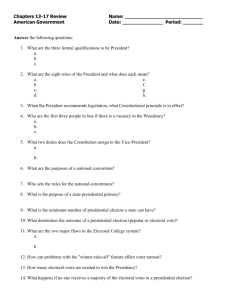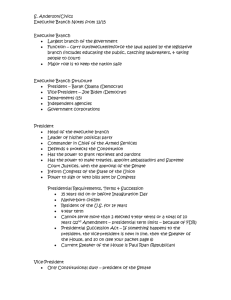UNIT
advertisement
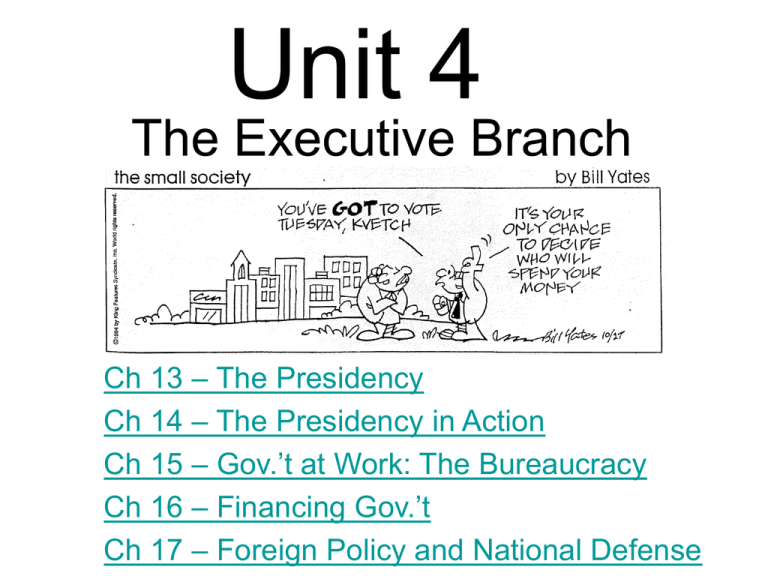
Unit 4 The Executive Branch Ch 13 – The Presidency Ch 14 – The Presidency in Action Ch 15 – Gov.’t at Work: The Bureaucracy Ch 16 – Financing Gov.’t Ch 17 – Foreign Policy and National Defense Ch 13 – The Presidency • The 8 _______ of the president Chief Citizen: representative of the people + expected to work for ______ __________ Chief of Party: leader of his ________________ Chief Legislator: main architect of the nation’s ______________ Chief Executive: has the power of the __________ branch The President Commander in Chief: head of the nation’s ______________ Chief of State: ceremonial head of the ________ Chief Administrator: directs the ________ gov.’t Chief Diplomat: main architect of _______________ + spokesman to other ________ • ___________ for the president • To run for President, the _____________ requires that the person: 1. Must be a _____________ __________ of the US. 2. Must be at least __ yrs old. 3. Must be a ________ of the US for at least ____ yrs. • The president’s • The president is elected to a _____ term term. • Originally there were ___________ on the presidency, but a 2 term ___________ became established. • Pres. ________________ was the only one to serve more than 2 terms. He was elected to 4 terms – but _______ w/in months of the beginning of his 4th term. • The _______________ officially limited the president to 2 terms (or up to 10 yrs. if he becomes president by _____________). • ____________ • Congress sets the president’s pay for the it is currently $__________ per yr. president • It cannot be increased in the middle of the _____________. • $50,000 _________________ per yr to be spent any way the president chooses • Resides in the White House + the ______________ retreat • Large __________ • Use of a fleet of automobiles, _____ _________ (as well as other planes + helicopters) • _______________ • Other fringe benefits End Section 1 • Presidential succession Who’s next in line to be president? *1. _____________________ *2. _______________________ *3. ______________________________ *4. ________________________ 5. Secretary of the Treasury 6. Secretary of Defense 7. Attorney General 8. Secretary of the Interior 9. Secretary of Agriculture 10. Secretary of Commerce 11. Secretary of Labor 12. Secretary of Health & Human Services 13. Sec. of Housing & Urban Development 14. Secretary of Transportation 15. Secretary of Energy 16. Secretary of Education 17. Secretary of Veterans Affairs 18. Secretary of Homeland Security • Presidential • _________ • • What if the president is _______________ his duties? Based on the ________________ (which also set up the presidential ___________), the v.p. can become acting president if: A. The president __________________ in writing, that he is unable to perform his duties as president, or B. The v.p. + a ____________________ inform Congress in writing that the president is unable to perform his duties The president resumes his duties once he informs Congress that he is ______________ _______. • If challenged by the v.p. + cabinet, Congress has _________ to decide the matter. • The ______ • Presidential candidates don’t chose their __________ ____________ based on their potential _____ to be president, but rather on their ability to balance the ticket (strengthen the candidate’s chance of being ________ by virtue of certain ideological, _________, racial, ethnic, gender, or other _______________). • The Constitution only assigns 2 duties to the v.p.: 1. To preside over the ___________. 2. To help decide the question of presidential __________. • The position of v.p. has been treated as a _____ until recently as v.p.s have been given ____________________. • The v.p. is the only person in the __________ branch that the president cannot ________. • ___ v.p.s have become president – 8 after the president’s death + 1 after Nixon’s ________________. End Section 2 • The origins of presidential __________ • The framers wanted to avoid the 2 obvious methods for choosing a president: 1. ___________ – believed that the people were scattered over too large an area + wouldn’t be able to make _________________. 2. __________________ – believed that would give the Congress too much _______ over the president (especially if the president wanted to be ____________). • Instead they came up w/ the electoral college (the group of people, known as electors, chosen from each state + D.C. to ____________ the president + v.p.). • The electoral • Each state would have as many __________ presidential electors as it has _______ + _______________ in Congress. ____________________________________________ • These electors would be chosen in the states, in whatever manner the states’ _____________ decided. • The electors cast a vote for the _______ + a separate vote for the ___ • The person receiving a majority of _______________ would become president (+ same for the v.p.). • If there was a _____ or no presidential candidate received a _________, The ________________________ would decide, voting by ______. End Section 3 • Choosing a • ___________ (along w/ D.C. + Puerto Rico) have presidential primaries – elections in which a candidate major party’s voters: primaries 1. choose ______________ of a state party organization’s __________ to their party’s national convention +/or 2. express a ___________ among various contenders for their party’s presidential nomination. • Primaries _______________ from state to state. • Most states prefer to have _______ dates (*NH passed a law to ensure that it always has the __ primary). B/c most of the primaries are held early in the year, __________________ + $ are especially important. • Primaries play the major part in deciding the presidential nominating contests in both parties – especially the party _____________. As for the party in power, the president is often seeking reelection or _______________. Either way, that person usually receives his party’s __________. • Choosing a • __________ have caucuses or ____________ – conventions to choose their caucus-conventions candidates for the major parties • Begins at the ____________, by nominating local officials + choosing delegates to the ______ elections. At the county level, they nominate county officials + choose delegates to the ______ elections. At the state level, they nominate state officials + chose delegates to the _______ level. At the national level they nominate their party’s candidate for _________ + _____ ____________. • Choosing a • National conventions are the meetings at _________ – which delegates of each _______ vote to the national pick their presidential + v.p. candidates. convention • Lasts 4 days + serves 3 major purposes: 1. Naming the party’s presidential + v.p. _____________. 2. Bringing the various factions + the leading personalities in the party together in one place for a __________________. 3. Adopting the party’s platform (a __________________ of basic principles, stands on __________ matters, + objectives for the campaign + beyond). End Section 4 Election Process January (even) 2008 Feb. Everyone joins in to be president Caucuses May June July Sept. Oct. Nov. Official Campaign March April Primaries and Fewer candidates General Election (Tuesday following 1st Monday) January (odd) 2009 20th: Inauguration Aug National Conventions Dec. Electoral College Votes (Monday following 2nd Wednesday) • Electing a • Remember, voters do not technically vote ____________ for a president + v.p., but for _______. The founding fathers intended the electors to use their ____________ in casting their electoral votes, but in reality, they almost always vote for their ___________________. • In 48 states, the electors are chosen ______ – so if a ______________ of voters vote Republican, all of the states electoral votes go to the Republican party – same w/ Democrats. • In ________ + __________ each party gets electors based on the ____________ of the votes the parties received in the popular vote. • To win, a candidate must received ____ out of 538 electoral votes. The Electoral College The oath to be taken by the president on first entering office is specified in Article II, Section 1, of the Constitution: I do solemnly swear (or affirm) that I will faithfully execute the office of President of the United States, and will to the best of my ability, preserve, protect, and defend the Constitution of the United States. • _______ in the 1. The winner of the ______________ doesn’t ____________ always win. This has happened 4 times: • • • • 1824: _______________ received over 38,000 votes than John Quincy Adams, the son of former President John Adams, but neither candidate won a majority of the electoral college. Adams was awarded the presidency when the election was thrown to the House of Representatives. 1876: _________________ received over 250,000 more votes than Republican Rutherford B. Hayes but lost the electoral vote by 1! 1888: Republican Benjamin Harrison lost the popular vote by 95,713 votes to President ___________________, but won the electoral vote by 65. In 2000, ___________ received 50,992,335 votes nationwide + George W. Bush received 50,455,156 votes. After Bush was awarded the state of Florida, he had a total of 271 electoral votes. 2. Electors are ___________ to vote in accord w/ the popular vote. • _________ electors have not voted for their party + 1 time an elector ________ to vote. So far, this has not altered the outcome of an election. 3. Any election might be decided in the _____ __________________. This has happened twice: • 1800 (_________________ over J. Adams) • 1824 (_________________ over H. Clay + A. Jackson) » “Corrupt Bargain” End Section 5 Ch 14 – The Presidency in Action • _______ of • Reasons for the increased power of the presidential presidency: ________ • ________ (only 1 president, but 535 members of __________) • _________ • __________ crises/national ___________ • Advances in ______________, transportation, + communication • The people’s demand for more ________ • ________ passed by Congress • General agreement among the people (consensus) End Section 1 • The president’s • Executing ______________ (enforces, ________ powers administers, carries out) • This requirement includes laws the president may ________. However, the president has the power to interpret those laws + decide how strictly to enforce those laws. • Issuing executive orders (a directive, rule, or regulation that has the ____________). His _____________ also have that power. • Ex. FDR ordered ____________ during WWII Carter created _________ • Making ______________ • Includes ambassadors; ___________________; federal judges, lawyers, + marshals; heads of independent ___________ (like Peace Corps); + officers in the armed forces – MUST BE ______________________________________. • _____________ appointees • The president may remove from office anyone he has appointed except for the v.p. + all federal __________. End Section 2 • The president’s • Makes __________ • MUST BE APPROVED BY A _________________ ___________ + MAJORITY. ______ powers • Congress may repeal a treaty by passing a law contrary to a provision in a treaty +/or repeal an existing law by the terms of a treaty. • Makes executive agreements (a pact b/w the president + the head of another _____). • Ex. Agreements for military bases + equipment • Recognizes the ______________ of foreign countries + their gov.’ts. • Usually done through the exchange of _______________. • US recently recognized South Sudan when it split from Sudan in 2011. • _____________________ • Technically, _______ must declare war. However, there are very few limits on the president’s ______ powers. End Section 3 • Makes legislative ___________________ • The president’s • Does this several times a year. The State of the ____________ + Union address is occurs in January, during which ________ powers the president addresses Congress + reports on the state of the nation – its domestic + foreign _______ – as well as laying out the policies his administration will __________. • May _______ laws • Can be __________ by a 2/3 Congressional vote rarely happens • Can call ____________________ of Congress • Rarely necessary • Can grant a reprieve – the _____________ of the execution of a sentence, a commutation the ________ of a penalty w/o forgiveness for the crime (person is still considered _____), or a pardon – the legal _________ of a crime. • • • • Except in cases of _______________. Only in regards to _________ crimes, not state. Can set ___________ on receiving a pardon. Can also grant amnesty (____________ to a group of violators). End Section 4 Ch 15 – Gov.’t at Work: The Bureaucracy • The bureaucracy • A large, complex administrative structure that handles the ________________ of an organization. • Can be public or private. • Public bureaucrats (people who work in a bureaucracy) are ________, not elected. • Red tape refers to ______ + _________ people may face when working w/ a bureaucracy. • There are 3 features of bureaucracies: 1. ______________ authority 2. Job ______________ 3. Formalized _______ • Although often viewed ________, bureaucracies are effective ways for people to work together on large + ____________ b/c of reduced conflicts over who’s in charge, efficiency since everyone has a specific task to work on, + ________ b/c decisions are based on rules. • The federal bureaucracy is all of the ________, people, + ___________ through which the federal gov.’t operates. • It is the _______ bureaucracy in the country. • It is the means by which the gov.’t makes + administers ____________. • All _________ of the gov.’t have bureaucracy, but the _________ branch has the largest by far. End Section 1 • The Executive • A complex organization of several Office of the separate agencies staffed by most of the President (EOP) President’s ______________ + assistants. • It is the president’s _____________. • Includes (but not limited to): • The ________________ (includes the chief of staff; press secretary; legal advisor; the president’s physician; the staff of the 1st lady; assistants in the economy, foreign policy, congressional relations, etc) • The _______________________ • The Office of Management + ______ (helps the president prepare a federal budget for the president to submit to Congress each year) • Other agencies for the economy, __________, technology, drug control, the v.p., etc… End Section 2 • The _________ • The 15 executive or cabinet departments each departments administer some __________ of activity. • The 1st Congress created ____________ (______, Treasury, + _____). Over time, new departments have been ________, expanded, + sometimes __________. • Each department is headed by a _________, except for the Department of _______ which is headed by the ______________. They: - make up the president’s _________ - __________ the president. - __________ their departments w/ the White House, Congress, + the ______. - are appointed by the president + confirmed by the ___________. • Most of each department’s work is done _________________ End Section 3 • Independent agencies • Additional agencies created by Congress located outside of the ______ (in all 3 branches of gov.’t) • Over 150 (ex. p.417) including: The _______ _________ Administration, NASA, EPA, Peace Corps, the ______, the FCC, US Postal Service, etc • Why aren’t they cabinets? Different reasons include: • They do not fit well w/in any ___________ • To protect them from the __________ _________ • ___________ • They handle especially _______ functions (ex. investigative commissions) • It is NOT because of ___ or ______ – The Social Security Administration is larger than all of the ________ except for the Health + Human Services department. End Section 3 • Types of • 3 main types: ____________ 1. Independent _______ agencies - (makes agencies up _______ of the independent agencies) • Very diverse - includes ________ _______, NASA, EPA, The Civil Rights Commission, The Federal __________ Commission, etc. 2. Independent __________ commissions – • Only 10 (p. 432) – includes the _______, SEC, _______, etc. • Regulate or police important aspects of the nation’s _________. • Make rules + regulations that have the __________ – acts on behalf of Congress. 3. Gov.’t Corporations – • Over 50 - includes the US _______ ________, the FDIC, the TVA, etc. End Section 4 • The civil service • _______ employees not appointed by the president who perform the _____________ work of the gov.’t. • Broad __________ from security guards to doctors. • All jobs have set __________ + people must pass a ____ to get these jobs w/ the highest _____ getting the jobs 1st. • Appointments are not based upon the current ____________________________. End Section 5 Ch 16 – Financing Gov.’t • The power to _____ • The federal gov.’t collects a couple of __________ in taxes every _______. • The power to tax is the ________ given to Congress in the Constitution. However there are some _____________: 1. Taxes must be raised for ____________ only - not private interests. 2. May NOT tax _________ from the US • but may place restrictions on what may be ___________ • may tax _________ 3. Direct taxes (income) must be evenly distributed among the __________ 4. Indirect taxes (all besides income) must be at the __________ throughout the states. 5. Cannot tax state + local _____________ functions. • The ______ tax • Started in 1913 w/ the ______ _____________. • ______________ of federal revenue today. • It is a progressive tax (adapted to the ______________ to pay – p. 449). • Levied on both individuals + ______________. • Tax returns (declaration of income + exemptions claimed) are due on ____________. • Other ____ • Payroll taxes – taxes that come out workers’ ___________ (self-employed are taxed for this as well). • For _____________, unemployment, old-age, _________, etc. • These are regressive taxes – taxes levied at a flat rate w/o regard for the ___________________ to pay them. • Excise taxes – taxes charged to the _____________. • Estate taxes – taxes charged on the assets of one who ___ (but only after $1.5 mil). • Gift taxes – taxes on gifts from one person to another over $__________. • Customs Duties (tariffs) – taxes on _________. • Why does Congress ___? • Mainly to raise $ to operate the ________________. • To __________ against an activity that Congress thinks is _______ +/or ___________ to the public. - alcohol, tobacco, etc. • To regulate things by _________ - hunting, certain firearms, prospecting on public lands, etc. End Section 1 • __________ • The federal gov.’t makes $ for sources revenues other than ________, such as: • _______________ from the FED • Collectors’ _________ • Profit from ______________ • Selling ______________ • _______ from federal courts • Gov.’t _____ • When the gov.’t spends more $ than it __________, it runs up a deficit. • When the gov.’t _________ more $ than it spends, it shows a surplus. • The public debt is the gov.’t’s total outstanding _________________. End Section 2 • Gov.’t • From 1776 to the mid-1930s, the gov.’t’s __________ income + spending were relatively small w/ ____________ on the ___________. • The _________________ changed everything. • The Department of _________________ __________ spends more than any other gov.’t agency (Medicare, Medicaid, etc) followed by the ________________ Administration. • These are entitlement programs – _______ that the law says all eligible people are __________ to. • The Department of _________ has the 3rd largest budget. • In 2004, __________________ was the 4th largest part of the federal budget! • The federal • About _____% of the federal budget is ________ ___________ – it has already been “________” (entitlement programs, interest payments, etc). • Work on the budget begins _________ before it would take effect. Federal agencies must submit budget proposals which they must _________ at budget hearings. The (usually revised) dollar amounts are then put into the _____________ proposed budget. • The president proposes a budget at the beginning of every year which _________ must approve (w/ changes). • ________ often testify at Congressional budget hearings + work to bring grass roots _________ on Congress. • The budget isn’t just a financial statement but a __________________________. End Section 3 Ch 17 – Foreign Policy and National Defense • National vs. • Domestic affairs – events w/in the _______ ___________ • Foreign affairs – the country’s __________ w/ other countries • Isolationism – a ____________________ to become generally involved in the affairs of the ________________ • Foreign policy - A group of policies made up of all the stands + ______ that a country takes in every aspect of its ___________ w/ other countries; everything a country’s gov.’t says + does in world affairs. • The president bears the _______________ for the making + the conduct of ______ ________. • The ________ Department • Advises the president on the formulation + conduct of the nation’s ________________. • Secretary of State ranks ______ among the president’s cabinet. • The State Department handles ________ issues. • Ambassadors are official representatives of the US appointed by the president to __________ the ______ in matters of diplomacy (the art + practice of conducting __________ b/w representatives of groups or states). • Ambassadors may be assigned to a particular _______, organization (UN, NATO, etc…), or to a special assignment (ex. ___________________). • Ambassadors (often other embassy officials + their families) are regularly granted diplomatic immunity, meaning they are not subject to the __________________ in which they are working. They cannot be __________, sued, or ________. Embassies cannot be entered or __________ w/o their consent, + they property/possessions are protected. • The _______ • The framers of the Constitution Department deliberately put the ___________ under the control of ________ at the highest level. The president is commander in chief + the Secretary of Defense cannot have served on ________ in the military for at least 10 yrs. before being named Secretary. • The Secretary of Defense is responsible for advising the president on the making + carrying out of _____________. • The Secretaries of the Air Force, Army, + Navy (under the Secretary of Defense) are all _______ while the Joint Chiefs of Staff are the highest ranking _________ officers. End Section 1 • Other _____ + _________ agencies • The CIA (Central __________ Agency) has 3 tasks: 1. To coordinate information-gathering activities of all federal agencies in ________________. 2. To analyze + evaluate all ____________ gathered. 3. To keep the president + National Security Council ___________ of all necessary intelligence. • Although much of its information is gathered through _________, a large portion comes from _____________. • It is _____ for the CIA to conduct any clandestine activities w/in the ______ (although the agency hasn’t always _________ that law). • The Department of ________________ was created to protect the US against ________. It was created shortly after _____. It’s major responsibilities include: 1. Border + ______________ security 2. Infrastructure protection 3. _________ preparedness + response 4. Information analysis (intelligence) 5. Chemical, biological, radiological, + _________________ • Some agencies were put under the Homeland Security Department’s authority such as the _____________, the Coast Guard, + Bureau of Immigration and ___________ Enforcement. • _______ (the National Aeronautics and Space Administration) has helped open research into astronomy, physics, environmental sciences, communications, + many other fields which have helped the strengthen the USA’s ___________ greatly. • The ______________________ requires that all _____ must register for the draft upon turning ____ yrs old although the draft has been inactive since 1973. End Section 2 • American • From America’s beginnings until WWI, America largely ____________ – practiced ___________ (although more true about the the highlights Eastern than the Western Hemisphere). • (1823) The Monroe Doctrine had 3 principles: 1. Warned all European powers not to interfere in the ___________________ 2. US wouldn’t involve itself in __________ affairs 3. US wouldn’t interfere w/ existing __________ * “You stay out of our backyard and we’ll stay out of yours” • The Roosevelt Corollary to the Monroe Doctrine - “Big Stick” Diplomacy – “Speak softly and carry a big stick” – T. Roosevelt • (1904) Gave the US the right to be an _________________________ to protect Latin America from European nations • Manifest Destiny - Belief held by many Americans that it was ___________ for the US to expand + to possess territory all the way to the Pacific Ocean + into Northern ___________. • Americans are God’s new chosen people + the west is the promised land • The _________________ War was brought on by yellow journalism + the explosion of the Maine. • _____ gains its indep. from Spain + US wins territories of _____________, Guam, + The Philippines. US sends troops to occupy Cuba + the Platt Amendment makes Cuba a ______________ of the US. • US becomes an _______________. • America follows a policy of isolationism (avoiding involvement in ________________) but is unable to avoid getting drawn into WWI. • After a year in WWI, the US retreated back to isolationism + refused to join the ______________ despite the fact that it was Pres. Wilson’s idea. • After being drawn in to _______, the US realized it could no longer retreat into isolationism. However, the overall objective of American foreign policy has always been the _________________________. • Began following the principle of collective security (keeping international peace + order). • Joined the ________________ (_____) • The ________ brought about NATO (North Atlantic Treaty Organization) b/w the US, _________, + ______________ against the Soviets + their allies. • The Cold War also brought about the __________ ______ (1947), based on the idea of Containment, which called for giving economic + military _____ to countries who rejected _______________. • Other events due to the Cold War include: • The ______________ • The ______________ • The Cuban Missile Crisis • The ______________ • The ______________ • The Arms Race + SALT I + II treaties • ___________ (Nixon – Carter) • Current major foreign policy concerns include the War on _______ + specifically the wars in _____ + Afghanistan, _____________ + Iran’s nuclear intentions, the instability of many African countries, clashes b/w India + Pakistan, fighting in the Middle East, etc… End Section 3 • Foreign aid • Economic + military aid to other countries • “Those who help others help themselves.” • Part of American foreign policy since the end of WWII + the beginning of the Cold War. • Since then the US has given over $500 BILLION to over 100 countries • Why should we give foreign aid? • Good will • Military security – gain allies, stop opposition from gaining allies • Alliances • Maintain international stability • Most of the economic foreign aid must be used to buy American goods. • Security • ______ – signed by the US, _______, + much of alliances ________________ in 1949 to protect Western Europe against _________ aggression. • An attack against one member was an attack against _____________. • Focus has shifted w/ the collapse of the ______. Besides a defensive response, it intervenes w/ conflicts that may ________ Europe (ex. The ______ in the mid 1990s) + in ______________ disasters. • The __________ (or Inter-American Treaty of Reciprocal Assistance) was signed in 1947. Currently the US, _________, + 32 _______________ countries have signed it. It serves a similar purpose as NATO. • The ANZUS Pact of 1951 does the same thing for the US, _________, + ________________. • The Korean Pact of 1953, pledges the US will come to the aid of South Korea if _____________. • Many others… • _________ • Started in 1945 at the end of ______ w/ the ___ as the 1st country to ratify the UN’s constitution/charter. • Based in ______. Meets in September (or during special sessions). • It’s goals are to maintain _______________ + security, to develop friendly relations b/w all nations, + to promote _________ + cooperation to solve international problems. • Has over _______ members. • _____________________ is made up of 1 representative from each member w/ each getting 1 vote. It can: • Make _______________ to the Security Council + others (not legally binding, but do carrying weight). • ______ 10 members to the Security Council, 54 to the Economic and Social Council, + some members of the Trusteeship Council. • Along w/ the Security Council, it selects the _______________ + the 15 judges of the ______________________________. • Shares w/ the Security Council the power to ____, suspend, or _______ members. • May ______________________ to its charter. • The _______________ bears the majority of responsibility for maintaining international ______. • It has 15 members: • 10 are ______ members who serve 2 yr terms. • 5 are ________ members (the ____, Britain, France, Russia – formerly the USSR, + ________). - All permanent members have _____________. • Resolutions require 9/15 vote (w/o the veto). • Has only called for military action _______. • May place economic +/or military ________ on offending nations. • May agree to provide _______________. • The World Health Organization (WHO) combats heath problems in _____________ countries. • The International Monetary Fund (IMF) promotes ______________________. • The International Bank for Reconstruction and Development (_________) makes loans for projects in developing countries. • The United Nations Educational, Scientific, and Cultural Organization (_____________) promotes many programs. • The International Court of Justice consists of 15 judges selected for 9 yr terms. Located in ____________, the Netherlands. It hears cases brought by members + nonmembers. Failure to comply w/ its judgment can lead to the other party going to the _____________. • The elected ______________ may bring any matter before the Security Council. He also prepares the _______ (must be approved by the General Assembly). • So what does it do? • _________________ • ___________ + social programs for the world’s ___________ countries • Loans $ to help _____________ in poorer countries • ____________ (eliminated smallpox completely + polio in the Americas) • Worked towards reducing ___________ • Worked towards protecting ___________ • Aids ____________ • Raises $ to help victims of wars + ______ __________ End Section 4
